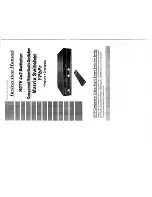
163
1.877.877.2269
BLACKBOX.COM
NEED HELP?
LEAVE THE TECH TO US
LIVE 24/7
TECHNICAL
SUPPORT
1.877.877.2269
CHAPTER 10: SECURITY
To understand why aging may be desired, consider the following scenario: Suppose an end-host is connected to a third-party
switch or hub, which in turn is connected to a port on this switch on which Port Security is enabled. The end-host will be allowed
to forward if the limit is not exceeded. Suppose that the end-host logs off or powers down. If it wasn’t for aging, the end-host
would still take up resources on this switch and will be allowed to forward. To overcome this situation, enable aging. With aging
enabled, a timer is started once the end-host gets secured. When the timer expires, the switch starts looking for frames from
the end-host, and if such frames are not seen within the next Aging Period, the end-host is assumed to be disconnected, and the
corresponding resources are freed on the switch.
Hold Time: The hold time—measured in seconds— is used to determine how long a MAC address is held in the MAC table if it has
been found to violate the limit. Valid range is between 10 and 10000000 seconds with a default of 300 seconds.
The reason for holding a violating MAC address in the MAC table is primarily to ensure that the same MAC address doesn’t give
rise to continuous notifications (if notifications on violation count is enabled).
Port Configuration
The table has one row for each port on the selected switch and a number of columns, which are:
Port: The port number for which the configuration below applies.
Mode: Controls whether Limit Control is enabled on this port. Both this and the Global Mode must be set to Enabled for Limit Control
to be in effect. Other modules may still use the underlying port security features without enabling Limit Control on a given port.
Limit: The maximum number of MAC addresses that can be secured on this port. This number cannot exceed 1024. If the limit is
exceeded, the corresponding action is taken.
The switch is “born” with a total number of MAC addresses from which all ports draw whenever a new MAC address is seen on a
Port Security-enabled port. Since all ports draw from the same pool, a configured address might not be granted, if the remaining
ports have already used all available MAC addresses.
Violation Mode: If Limit is reached, the switch can take one of the following actions:
- Protect: Do not allow more than Limit MAC addresses on the port, but take no further action.
- Restrict: If Limit is reached, subsequent MAC addresses on the port will be counted and marked as violating. Such MAC
addresses are removed from the MAC table when the hold time expires. At most Violation Limit MAC addresses can be marked
as violating at any given time.
- Shutdown: If Limit is reached, one additional MAC address will cause the port to be shut down. This implies that all secured MAC
addresses be removed from the port, and no new addresses be learned. There are three ways to re-open the port:
1) In the “Configuration→Ports” page’s “Configured” column, first disable the port, then restore the original mode.
2) Make a Port Security configuration change on the port.
3) Boot the switch.
Violation Limit: The maximum number of MAC addresses that can be marked as violating on this port. This number cannot exceed
1023. Default is 4. It is only used when Violation Mode is Restrict.
State: This column shows the current state of the port as seen from the Limit Control’s point of view. The state takes one of four
values:
- Disabled: Limit Control is either globally disabled or disabled on the port.
- Ready: The limit is not yet reached. This can be shown for all actions.
- Limit Reached: Indicates that the limit is reached on this port. This state can only be shown if Action is set to none or Trap.
- Shutdown: Indicates that the port is shut down by the Limit Control module. This state can only be shown if Action is set to
Shutdown or Trap and Shutdown.
Buttons
Apply: Click to save changes.
Reset: Click to undo any changes made locally and revert to previously saved values.
















































